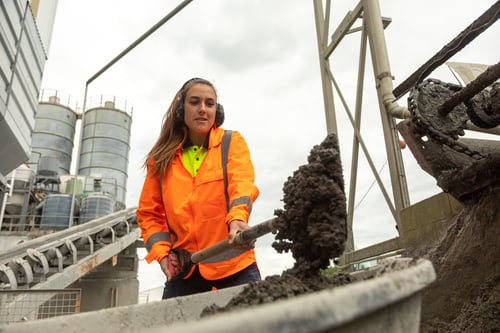Cement Shortages, Concrete Inflation Threaten Biden’s Building Boom
 Concrete is the most ubiquitous human-made substance on earth, so it was inevitable the global inflationary spiral would come for this energy-intensive material too. Soaring cement costs and concrete shortages are a threat to US President Joe Biden’s infrastructure and manufacturing reshoring ambitions and our monetary guardians’ efforts to curtail rampant price appreciation.
Concrete is the most ubiquitous human-made substance on earth, so it was inevitable the global inflationary spiral would come for this energy-intensive material too. Soaring cement costs and concrete shortages are a threat to US President Joe Biden’s infrastructure and manufacturing reshoring ambitions and our monetary guardians’ efforts to curtail rampant price appreciation.
Cement prices are surging on both sides of the Atlantic as producers passed on higher energy and pollution-compliance costs to customers and then kept hiking prices even as their gas and electricity bills receded. European cement prices increased by around one third last year, with some nations recording much higher increases. In the US, cement prices are increasing at a 15% annual rate; tight supplies and outright shortages have affected much of the country.
Building contractors who hoped they’d seen the back of input-cost inflation – steel and timber prices have fallen a lot lately – must instead endure another year of rising cement prices, or face going without. The world’s largest cement producers, several of which are European. can scarcely believe their luck.
Holcim Ltd., HeidelbergCement AG, CRH Plc and Cemex SAB de CV spoke glowingly of US demand and their own pricing power in recent weeks. Holcim said several North American product categories were “sold out” and its profit margins were therefore set to hit a “very sweet spot” in 2023. Dallas-based Eagle Materials Inc. said its cement business was “near sold-out” while Midwest cement producer Summit Materials Inc. said it was seeing “tremendous pricing momentum” and was “out of capacity because we are running full out.”
After initially struggling to pass on rising energy bills to customers, price increases are now clearly outpacing input costs. “Inflation supports a constructive pricing environment for our upstream materials, the benefits of which long endure after inflationary pressures abate,” Ward Nye, chief executive officer of Texas cement producer Martin Marietta Materials Inc., told investors in February.
While it’s understandable that producers want to restore margins to pre-energy crisis levels, this is something customers should keep an eye on as there’s growing evidence of businesses using public perceptions of a crisis to pad their profits well after the initial problem has passed.
While US home construction has cooled and turmoil in the banking sector has increased the likelihood of a recession, non-residential construction is still going gangbusters thanks partly to a trifecta of legislation: the Infrastructure Investment and Jobs Act, Chips Act and Inflation Reduction Act. Semiconductor fabs, battery plants, highways and bridges require ridiculous amounts of concrete.
Due to their bulk and comparatively high transportation costs, cement and concrete are typically made close to where they’re used and prices are determined by local circumstances. Cement prices are inelastic due to a lack of substitutes, giving local producers considerable market power. While concrete typically represents only a small proportion of overall construction costs, any delays can be costly.
Various factors have combined to turn this into even more of a sellers’ market. Growing demand for lower carbon cement has made it easier for manufacturers to charge a premium for these products. For European producers, the high cost of purchasing carbon-emission certificates has further boosted cement prices and discouraged price-sapping capacity growth. (The EU’s new carbon border tax is expected to deter cement imports.)
In the US, a lack of truck drivers, low water levels on the Mississippi river (which limited barge traffic) and plant maintenance shutdowns have all constrained supply.
The US hasn’t added significant amounts of cement capacity for more than a decade and 84% of domestic production is now foreign owned, meaning Washington has less influence over the industry.
It’s hard to get approval for new cement plants, Ken Simonson, chief economist at the Associated General Contractors of America, told me. “They aren't desirable neighbors, they are huge users of fossil fuel, and the investment return is uncertain.”
Eagle Materials CEO Michael Haack also doesn’t expect a rapid supply response. “Barriers to capacity addition are very high for the US cement industry, both in terms of permitting and construction cost,” he told investors in January. “High-cost imports will increasingly be required to meet US demand.”
Imports are already needed to cover about one-fifth of US cement consumption, compared to just 7% a decade ago. Turkey is the biggest source – contributing more than one-third of US cement imports – which is a worry because it may need to prioritize its domestic market following February’s devastating earthquake.
The Biden administration’s goal of using American-made goods in federally-funded infrastructure projects may be about to smash into a concrete wall.
Chris Bryant is a Bloomberg Opinion columnist covering industrial companies in Europe. Previously, he was a reporter for the Financial Times.
This article was written by Chris Bryant from Bloomberg and was legally licensed through the Industry Dive Content Marketplace. Please direct all licensing questions to legal@industrydive.com.

-1.png?width=112&height=112&name=image%20(4)-1.png)













